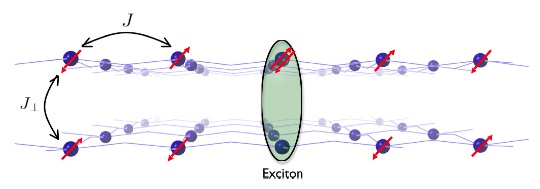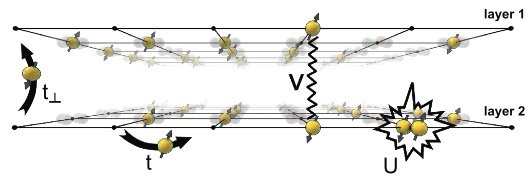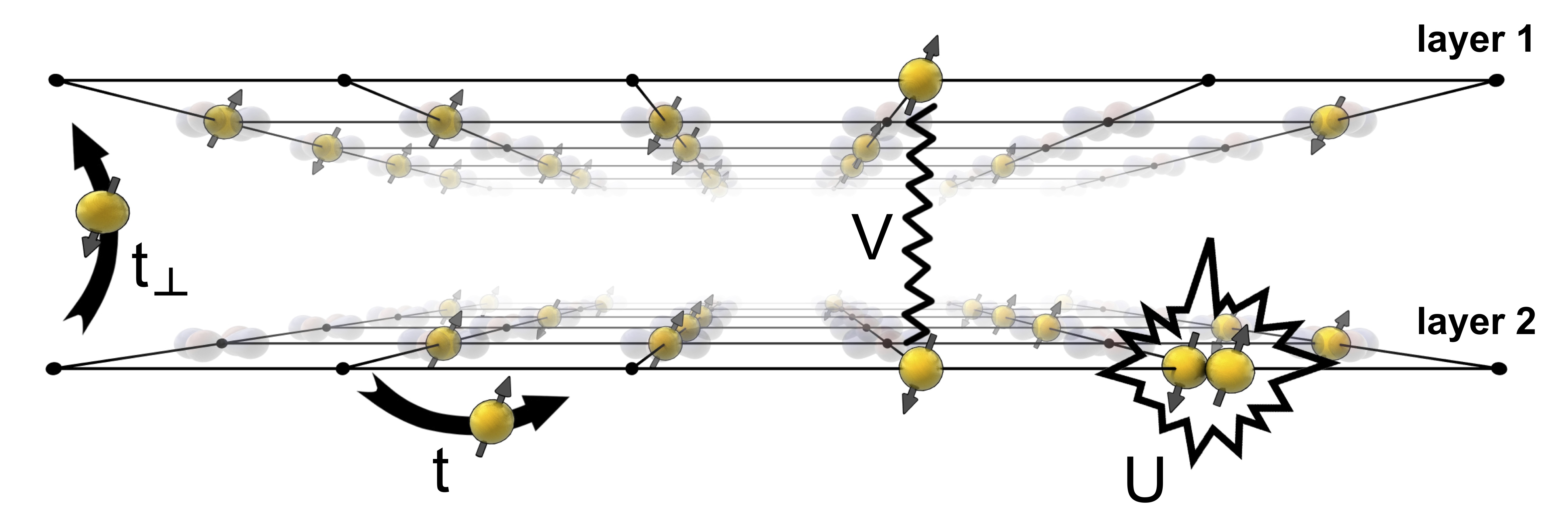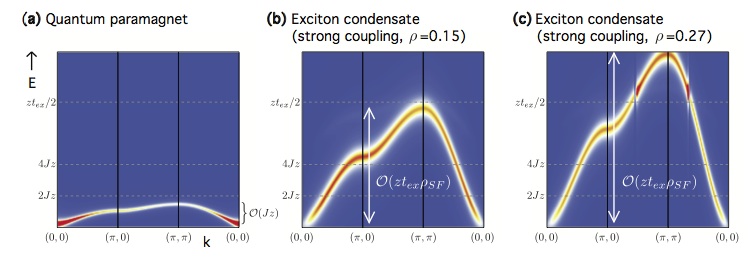Title: Exciton condensation in strongly correlated electron bilayers
Abstract: We studied the possibility of exciton condensation in Mott insulating bilayers. In these strongly correlated systems, an exciton is the bound state of a double occupied and empty site. In the strong coupling limit, the exciton acts as a hard-core boson. Its physics is captured by the exciton t-J model, containing an effective XXZ model describing the exciton dynamics only. Using numerical simulations and analytical mean-field theory, we constructed the ground-state phase diagram. Three homogeneous phases can be distinguished: the antiferromag- net, the exciton checkerboard crystal, and the exciton superfluid. For most model parameters, however, we predict macroscopic phase separation between these phases. The exciton superfluid exists only for large exciton hopping energy. Additionally, we studied the collective modes and susceptibilities of the three phases. In the superfluid phase, we find the striking feature that the bandwidth of the spin-triplet excitations, potentially detectable by resonant inelastic x-ray scattering (RIXS), is proportional to the superfluid density. The superfluid phase mode is visible in the charge susceptibility, measurable by RIXS or electron energy loss spectroscopy (EELS).
Publication: Determinant quantum Monte Carlo study of exciton condensation in the bilayer Hubbard model
Title: Determinant quantum Monte Carlo study of exciton condensation in the bilayer Hubbard model
Abstract: We studied the possibility of exciton condensation in a strongly correlated bilayer extended Hubbard model using determinant quantum Monte Carlo. To model both the on-site repulsion U and the interlayer interaction V we introduced an update scheme extending the standard Sherman-Morrison update. We observe that the sign problem increases dramatically with the inclusion of the interlayer interaction V, which prohibits at this stage an unequivocal conclusion regarding the presence of exciton condensation. However, enhancement of the interlayer tunneling results suggest that the strongest exciton condensation tendency lies around 10–20% p/n doping. Magnetic properties and conductivity turn out to be relatively independent of the interlayer interaction.
Reference: Louk Rademaker, Steve Johnston, Jan Zaanen, and Jeroen van den Brink, Phys. Rev. B 88, 235115 (2013)
PhD defense – “Fermions and Bosons: excitons in strongly correlated materials”
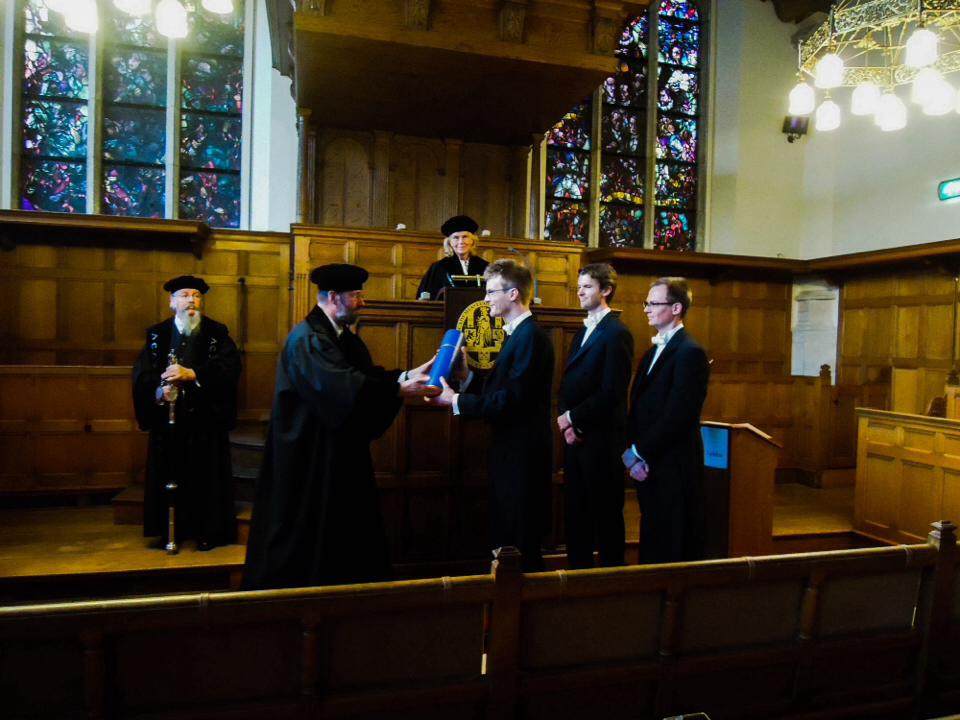
This Wednesday 11 December 2013 I obtained by PhD degree, after completing all the traditional Dutch ceremonial requirements (as you can see on the photo).

For those of you who want to read more:
- The thesis itself can be downloaded via the website of the Leiden University library.
- A link to the Dutch summary, which is aimed at the laymens level.
Furthermore, there has been some press coverage of the defense.
- ‘Promoveren als familietraditie‘ – a news item in Dutch on the website of Leiden University.
- A ‘review’ of the Dutch summary by my aunt Leonore Noorduyn: “Hoe je met super-ingewikkelde kennis toch begrepen wordt“
-
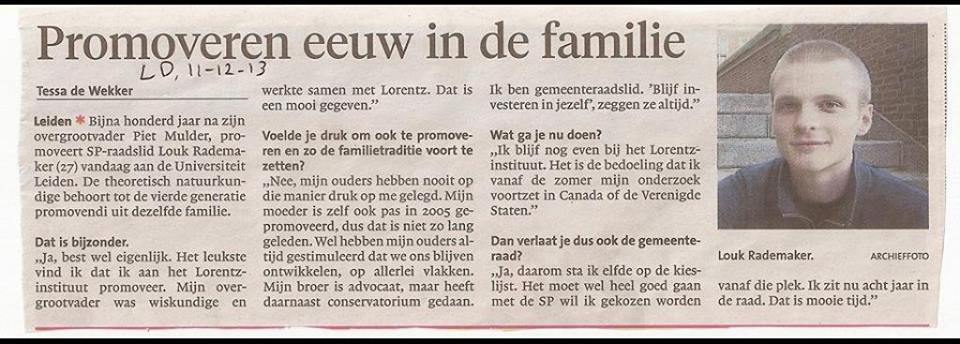
Publication in the Leidsch Dagblad on the day of my PhD defense.
arXiv preprint: Exciton condensation in strongly correlated electron bilayers
Title: Exciton condensation in strongly correlated electron bilayers
Abstract:We studied the possibility of exciton condensation in Mott insulating bilayers. In these strongly correlated systems an exciton is the bound state of a double occupied and empty site. In the strong coupling limit the exciton acts as a hard-core boson. Its physics are captured by the exciton t-J model, containing an effective XXZ model describing the exciton dynamics only. Using numerical simulations and analytical mean field theory we constructed the ground state phase diagram. Three homogeneous phases can be distinguished: the antiferromagnet, the exciton checkerboard crystal and the exciton superfluid. For most model parameters, however, we predict macroscopic phase separation between these phases. The exciton superfluid exists only for large exciton hopping energy. Additionally we studied the collective modes and susceptibilities of the three phases. In the superfluid phase we find the striking feature that the bandwidth of the spin-triplet excitations, potentially detectable by resonant inelastic x-ray scattering (RIXS), is proportional to the superfluid density. The superfluid phase mode is visible in the charge susceptibility, measurable by RIXS or electron energy loss spectroscopy (EELS).
Reference: Louk Rademaker, Jeroen van den Brink, Jan Zaanen, Hans Hilgenkamp, arXiv:1310.0685
arXiv preprint: Determinant quantum Monte Carlo study of exciton condensation in the bilayer Hubbard model
Title: Determinant quantum Monte Carlo study of exciton condensation in the bilayer Hubbard model
Abstract: We studied the possibility of exciton condensation in a strongly correlated bilayer extended Hubbard model using Determinant Quantum Monte Carlo. To model both the onsite repulsion U and the interlayer interaction V we introduced a novel update scheme extending the standard Sherman-Morrison update. We observe that the sign problem increases dramatically with the inclusion of the interlayer interaction V, which prohibits at this stage a unequivocal conclusion regarding the presence of exciton condensation. However, enhancement of the interlayer tunneling results suggest that the strongest exciton condensation tendency lies around 10-20 % p/n-doping. Magnetic properties and conductivity turn out to be relatively independent of the interlayer interaction.
Reference: Louk Rademaker, Steve Johnston, Jan Zaanen, Jeroen van den Brink, arXiv:1310.0623
Publication: Enhancement of spin propagation due to interlayer exciton condensation
Our latest paper, just published on-line in Phys. Rev. B Rapid Communications!
Title: Enhancement of spin propagation due to interlayer exciton condensation
Abstract: We show that an interlayer exciton condensate doped into a strongly correlated Mott insulator exhibits a remarkable enhancement of the bandwidth of the magnetic excitations (triplons). This triplon is visible in the dynamical magnetic susceptibility and can be measured using resonant inelastic x-ray scattering. The bandwidth of the triplon scales with the exciton superfluid density, but only in the limit of strong correlations. As such the triplon bandwidth acts as a probe of exciton-spin interactions in the condensate.
Reference: Louk Rademaker, Jeroen van den Brink, Hans Hilgenkamp and Jan Zaanen, Phys. Rev. B 88, 121101(R) (2013).
Publication: Dynamics of a single exciton in strongly correlated bilayers
The extended paper on the properties of a single exciton, following up on my earlier Europhys Lett, is accepted and published in the New Journal of Physics.
Title: Dynamics of a single exciton in strongly correlated bilayers
Abstract: We formulated an effective theory for a single interlayer exciton in a bilayer quantum antiferromagnet, in the limit when the holon and doublon are strongly bound onto one interlayer rung by the Coulomb force. Upon using a rung linear spin-wave approximation of the bilayer Heisenberg model, we calculated the spectral function of the exciton for a wide range of the interlayer Heisenberg coupling α = J⊥/Jz. In the disordered phase at large α, a coherent quasi-particle peak appears, representing free motion of the exciton in a spin singlet background. In the Néel phase, which applies to more realistic model parameters, a ladder spectrum arises due to Ising confinement of the exciton. The exciton spectrum is visible in measurements of the dielectric function, such as c-axis optical conductivity measurements.
Reference: Louk Rademaker, Kai Wu and Jan Zaanen, New J. Phys. 14, 083040 (2012).
arXiv preprint: Dynamics of a single exciton in strongly correlated bilayers
Title: Dynamics of a single exciton in strongly correlated bilayers
Abstract: We formulated an effective theory for a single interlayer exciton in a bilayer quantum antiferromagnet, in the limit that the holon and doublon are strongly bound onto one interlayer rung by the Coulomb force. Upon using a rung linear spin wave approximation of the bilayer Heisenberg model, we calculated the spectral function of the exciton for a wide range of the interlayer Heisenberg coupling \alpha=J_{\perp}/Jz. In the disordered phase at large \alpha, a coherent quasiparticle peak appears representing free motion of the exciton in a spin singlet background. In the N\'{e}el phase, which applies to more realistic model parameters, a ladder spectrum arises due to Ising confinement of the exciton. The exciton spectrum is visible in measurements of the dielectric function, such as c-axis optical conductivity measurements.
Reference: Louk Rademaker, Kai Wu and Jan Zaanen, arXiv:1202.3616
Publication: The dynamical frustration of interlayer excitons delocalizing in bilayer quantum antiferromagnets
The paper on the properties of a single exciton is accepted and published in the January issue of Europhysics Letters! (See the completely different arXiv version here.)
Title: The dynamical frustration of interlayer excitons delocalizing in bilayer quantum antiferromagnet
Abstract: Using the self-consistent Born approximation we study the delocalization of interlayer excitons in the bilayer Heisenberg quantum antiferromagnet. Under realistic conditions we find that the coupling between the exciton motion and the spin system is strongly enhanced as compared to the case of a single carrier, to a degree that it mimics the confinement physics of carriers in Ising spin systems. We predict that the “ladder spectrum” associated with this confinement physics should be visible in the c-axis exciton spectra of insulating bilayer cuprates such as YBa2Cu3O6. Our discovery indicates that finite density systems of such excitons should show very rich physical behavior.
Reference: Louk Rademaker, Kai Wu, Hans Hilgenkamp and Jan Zaanen, EPL 97, 27004 (2012).
Presentation: Frustrated interlayer excitons in antiferromagnets
On 9 September 2011 I was presenting my work on interlayer excitons (see this preprint) at the University of Utrecht in the so-called ‘BEC group meeting’ (that is: the groups of Henk Stoof, Rembert Duine and Cristiane de Morais Smith combined).
Title: Frustrated interlayer excitons in antiferromagnets (click to download the presentation in PDF, 3.6 MB)

